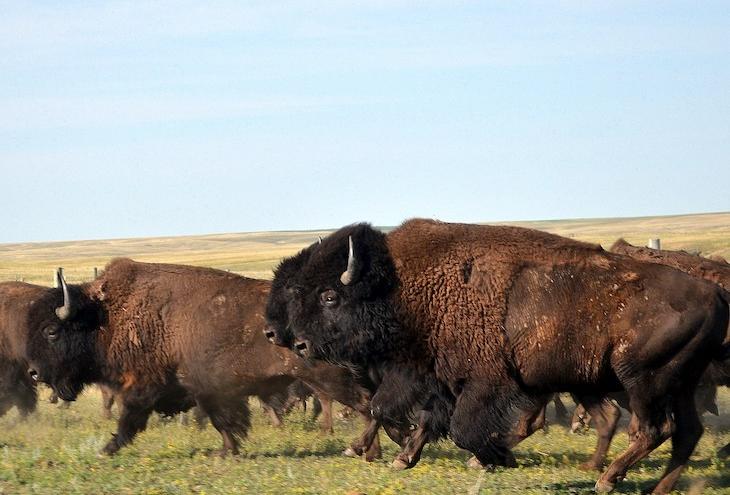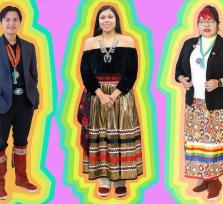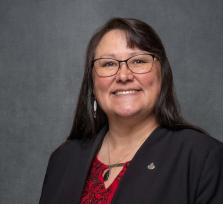Protecting the animals that support the life of a community has always been a focus for Indigenous people. In some places that mission became a bit easier during the pandemic lockdown, as the human retreat gave animals space to flourish. But the mission goes on and its importance transcends nutrition because the species that sustain a community inevitably become an inextricable part of its culture.
If anything, for many tribes the cause of caring for their culturally significant animals is made more compelling by dual goals of healing the Earth in an era of climate change and advancing food sovereignty. Bison and marine species, especially salmon, are two that have long sustained tribes, whose members are working hard to foster and protect these animals.
Restoring an Icon
Bison once roamed the vast open spaces of the West in the hundreds of thousands. But by the early 1900s, wholesale slaughter to make room for railroads and ranches left only a few hundred on the Great Plains. Over the years, tribal members joined with wildlife conservationists to save the last of these animals. On different pockets of public lands in the early 20th century, bison started to come back.
Fast-forward to 1992 when representatives from the Native American Fish and Wildlife Society in Colorado looked at returning and restoring buffalo to tribal lands. They started what was then called the InterTribal Bison Cooperative, focused on a single goal. “The mission was to return buffalo to Indian Country for spiritual and cultural purposes,” says Executive Director Arnell Abold, who’s been with the organization since 2001. The group pushed for and was granted a federal charter through the Bureau of Indian Affairs.
In the beginning the cooperative provided grants and assisted tribes with training and herd management. Initially about 17 tribes were part of the cooperative, headquartered in Rapid City, S.D. Eventually, the group was granted a federal charter and changed its name to the InterTribal Buffalo Council (ITBC), which now serves almost 70 tribes.
Benefits of Restoration
Today, there are over 20,000 buffalo on tribal lands. “It’s not just the buffalo that are returned to the tribes,” explains Megan Davenport, ITBC wildlife biologist. It’s also about bringing back traditional activities surrounding the buffalo. “How many children have tasted buffalo meat for the first time?” asks Davenport. “How many elders are able to experience it for the first time in a very long while? How many ceremonies can be brought back?”
Beyond the cultural benefits, there are advantages to the animals when tribes, rather than the federal government, raise them. And because the council redistributes surplus bison from national parks, especially Yellowstone, where genetically significant descendants of original herds roam, they help maintain the long-term health of populations on tribal lands. In addition, the ITBC helps restore the ecosystem that supports the buffalo — prairie grasses are a notable example.
One of the council’s longstanding members, the Quapaw Nation of Oklahoma, has been able to develop economic opportunities and strengthen their food security and food sovereignty through their bison program, which maintains a herd of 200 (and a cattle herd of 1,300). In 2017, the tribe started a meat processing plant near their headquarters in Miami, in northeast Oklahoma. In addition to providing meat for tribal citizens, the tribe sells buffalo jerky and other smoked meats, and serves the meat in their casinos.
For Davenport, the Quapaw Nation is a success story. “They are a wonderful resource for many of our other tribes who are also looking to develop meat processing plants and different food businesses that can help support not only food for the communities, but some economic growth,” she says.
Because of the Quapaw bison, the tribe’s processing plant has grown. During the pandemic, many plants in the Oklahoma, Arkansas, and Missouri region were unable to fill orders, but Quapaw Nation’s plant has been able to take them on, and now the plant is booked until spring of 2021 and is actively recruiting workers.
Other tribes are also benefiting from partnership with the ITBC, which this year helped 16 tribes resettle bison from national parks. This past August, two bulls traveled from the Fort Peck Reservation in Montana, having originated in Yellowstone National Park and gone through a rigorous quarantine protocol in the first tribe-to-tribe transfer of Yellowstone buffalo. Principal Chief Chuck Hoskin Jr. told the Cherokee Phoenix that the ITBC has helped the tribe grow the herd, which now numbers 180. “Historically, bison provided an essential food source for tribes,” he said. “The newly acquired bison will help revive some ancient cultural traditions, as well as provide expanded economic opportunities for future generations of Cherokees.”
Funding the Future
For the ITBC, continuing success hinges on money from the federal government and foundations. “There is limited funding and resources right now to support these kinds of programs,” says Abold. “The funding we get from the federal government covers about 5 percent of what tribes need to run their herds on an annual basis.”
The council is looking for other sources of funding, as well as working to secure additional and more permanent federal funding to support its programs. One piece of legislation that would allocate more funding for ITBC is the Indian Buffalo Management Act (H.R. 5153).
For Davenport and Abold, success comes down to the resources available to tribes. “That’s where most of the challenges come from, although the situation looks entirely different across the 69 tribes we work with,” says Davenport.
The reward for meeting that challenge is honoring the past and ensuring the future with flourishing herds of bison. “These are incredibly resilient animals,” says Davenport. “We are learning from them at all times.”











